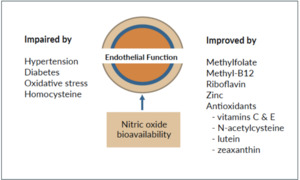Maintenance of a good blood flow through the eye is crucial and impairment or dysregulation of blood flow is a likely cause of several diseases of the eye. In particular, raised retinal venous pressure (RVP) has many adverse effects.1 The blood vessels in the retina are unusual in that they are not innervated by autonomic nerves and the control of blood flow is largely mediated by local release of vasoactive substances, mainly from the vascular endothelium. Hence, impaired blood flow is often the consequence of the impaired function of the vascular endothelium (vascular endotheliopathy), which can be caused by hypertension, diabetes, oxidative stress and raised plasma homocysteine (Figure 1), or by primary vascular dysregulation (the Flammer syndrome).2,3
Although there are pharmacological approaches to improving vascular endothelial function, these may be accompanied by unwanted side effects. An alternative approach is to treat the patient with nutrients that have known beneficial actions on the endothelium. Perhaps the most important factor that reflects the health of the vascular endothelium is the production and action of nitric oxide. So we need to identify treatments that improve nitric oxide bioavailability and stability. As in other vascular beds, nitric oxide plays a key role in maintaining normal vascular function in the eye,6 where it probably mediates both arterial and venous dilation,7 increased blood flow and reduced intraocular pressure.8 Some substances that can improve nitric oxide bio-availability are shown in Figure 1. Several of these substances have additional beneficial effects, such as lowering the concentration of homocysteine – an amino acid that is toxic to the endothelium. These substances include the bioactive natural form of folate – L-methyl folate, which both increases the production of nitric oxide and lowers homocysteine.9,10 Raised homocysteine is an established risk factor for many vascular and brain diseases11 and for retinal vascular occlusive disease,12 diabetic retinopathy5,13 and age-related macular degeneration.14
Homocysteine concentrations are influenced by common genetic polymorphisms but are mainly determined by the status of two B vitamins, folate and vitamin B12. In a significant proportion of the population, the B vitamin status is suboptimal, leading to modestly raised homocysteine, which can be corrected by taking B vitamins. Folate is probably the most relevant B vitamin: methylfolate supplies the methyl group that converts homocysteine to methionine, so regenerating an essential amino acid and lowering homocysteine levels. Folic acid, a synthetic substance that is not equivalent to methylfolate, is widely used as a supplement, but there are concerns about its adverse effects.15,16
There is no single factor that can alleviate impaired blood flow in the eye: a combination of different substances is needed to enhance nitric oxide bioavailability and lower homocysteine. A commercial medical food called Ocufolin® contains methyl folate and several other key ingredients which act as antioxidants, some of which also lower homocysteine, such as N-acetylcysteine17 and zinc.18 Furthermore, under certain circumstances, the B vitamins B2, B6 and B12 also lower homocysteine.11
In preliminary studies, Ocufolin® has been shown to improve symptoms in diabetic and hypertensive retinopathy even in long-standing cases,4 with the resolution of retinal hemorrhages and microaneurysms and the reduction of exudates and macular edema. Furthermore, Ocufolin® markedly lowered plasma homocysteine in diabetic patients by an average of 32%19 and it lowered retinal venous pressure in a pilot study (unpublished). Because Ocufolin® is scientifically formulated and contains only natural nutrients, it is safe and without adverse side effects. Furthermore, as well as being beneficial to the eye, the ingredients have more general benefits for the cardiovascular and nervous systems.11
Conflict of Interest
ADS is on the scientific advisory board of Aprofol.

